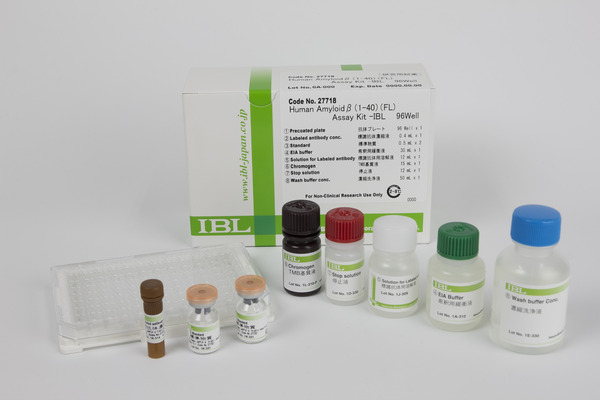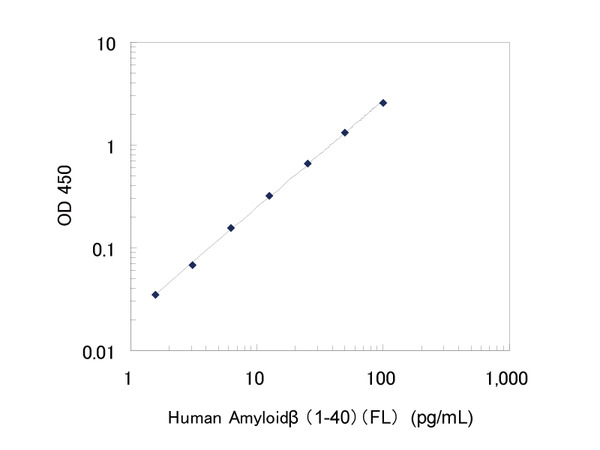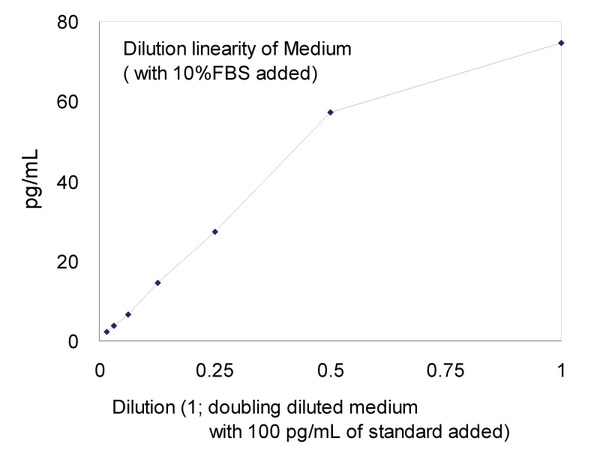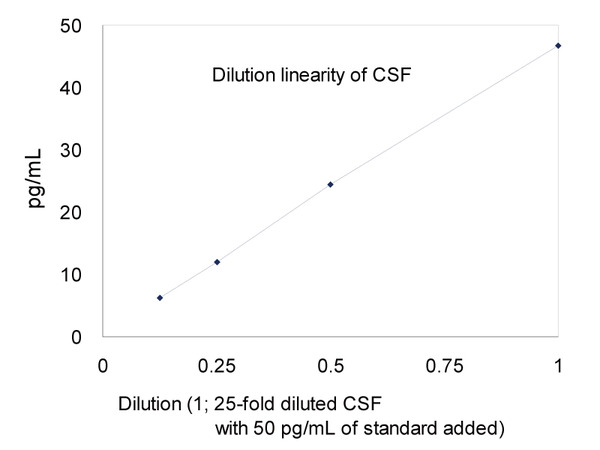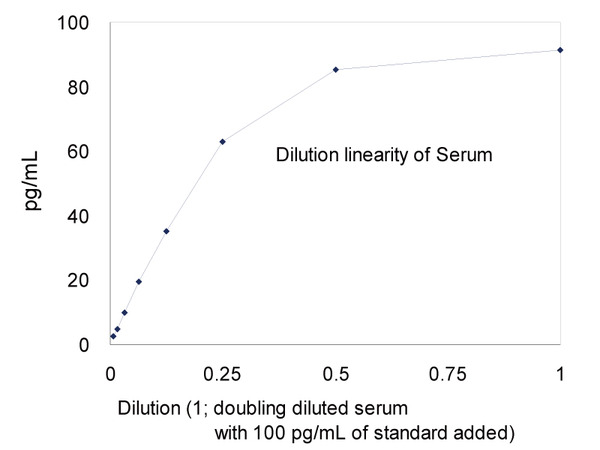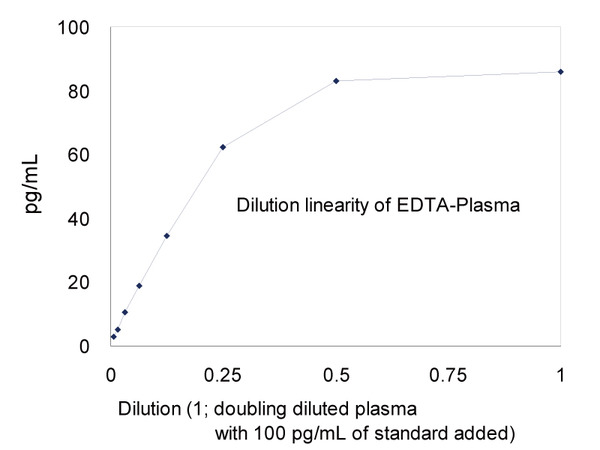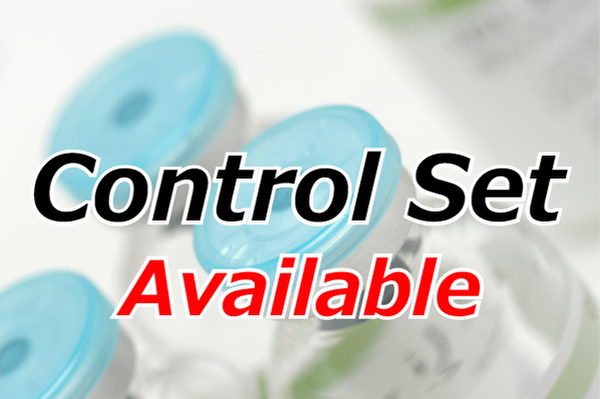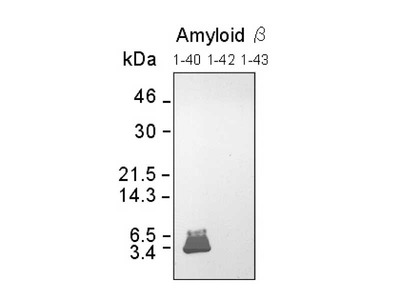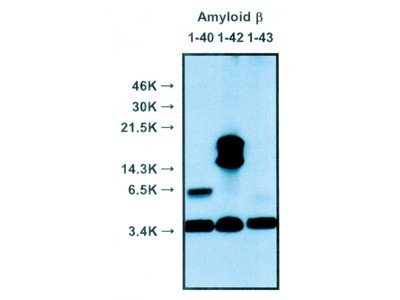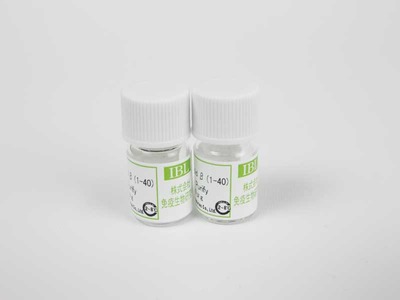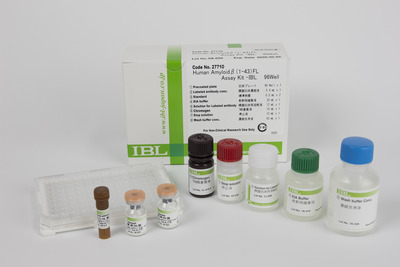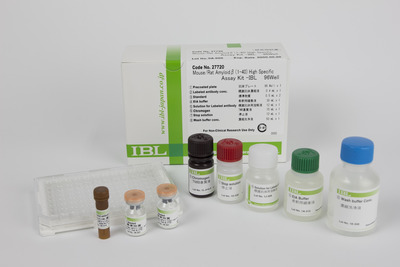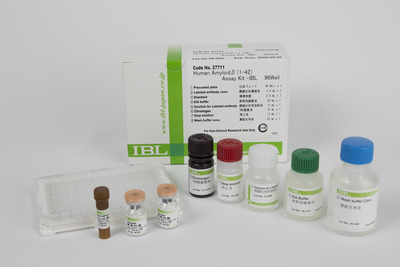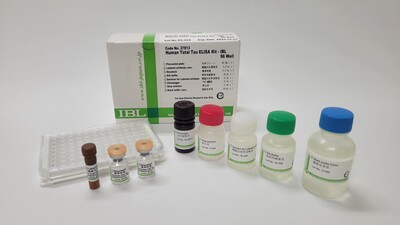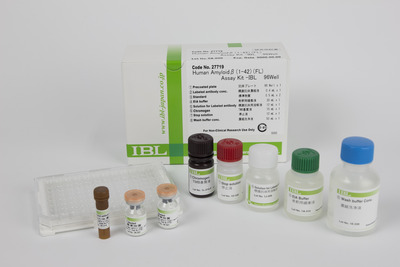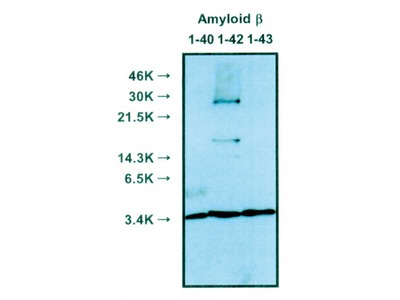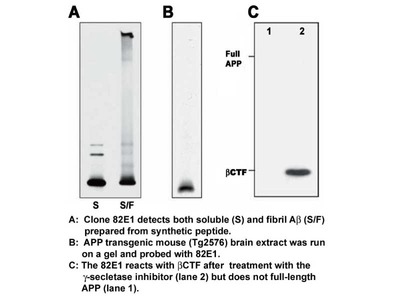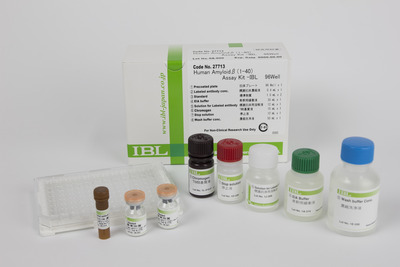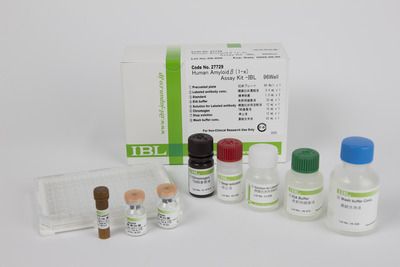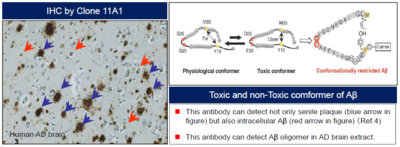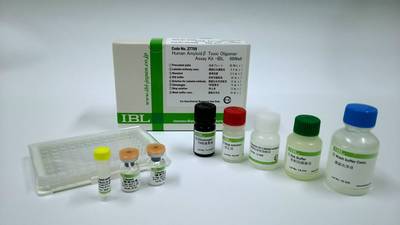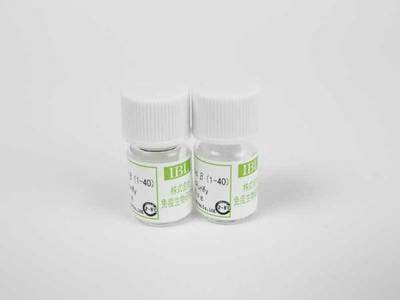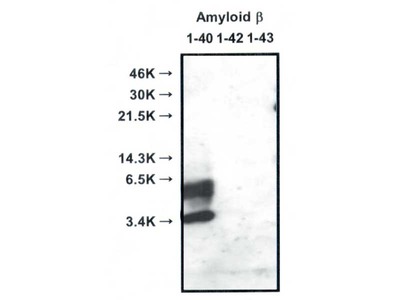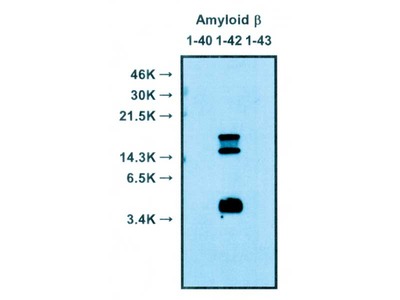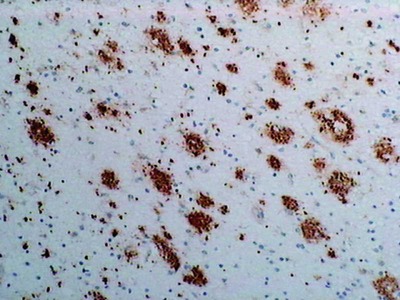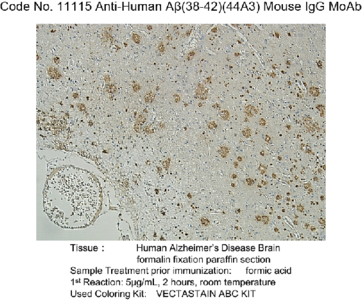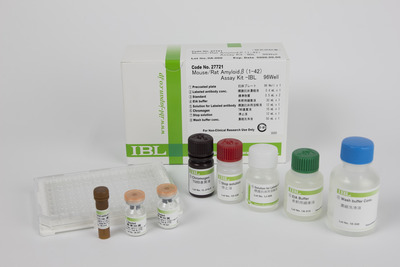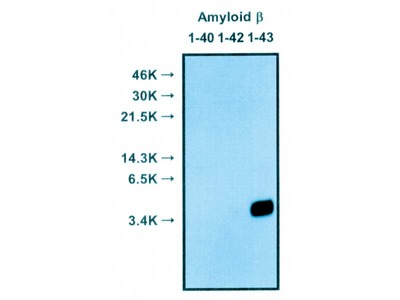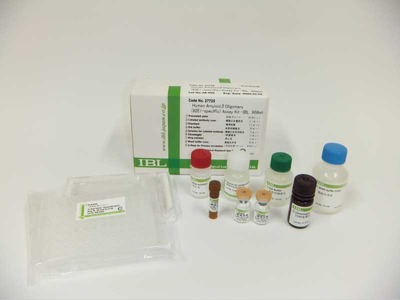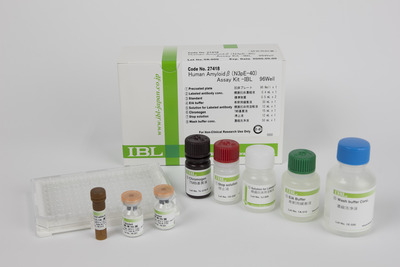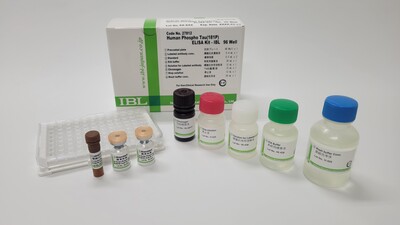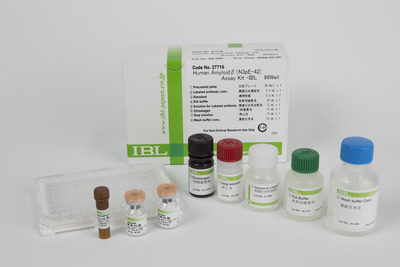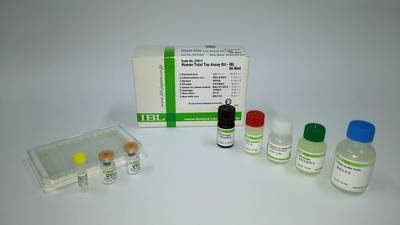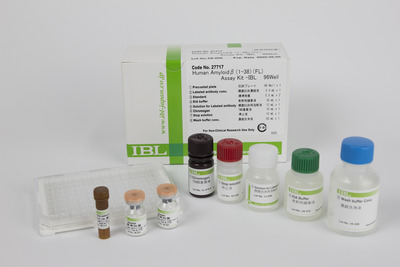- HOME >
- For Researchers >
- Product Search >
- Search Result >
- #27718 Human Amyloidβ (1-40) (FL) Assay Kit - IBL
Product Search
#27718 Human Amyloidβ (1-40) (FL) Assay Kit - IBL
- Intended Use:
- Research reagents
- Measuring Method:
- ELISA
- Sample Types:
- Human
- Measuring Samples:
- EDTA-plasma, Serum, CSF, Brain tissue extract, Cell culture supernatant
- Measurement Range:
- 1.56 - 100 pg/mL
- Package Size1:
- 96 Well
※ The product indicated as "Research reagents" in the column Intended Use cannot be used
for diagnostic nor any medical purpose.
※ The datasheet listed on this page is sample only. Please refer to the datasheet
enclosed in the product purchased before use.
Product Overview
Product Overview
| Product Code | 27718 |
|---|---|
| Product Name | Human Amyloidβ (1-40) (FL) Assay Kit - IBL |
| Intended Use | Research reagents |
| Measuring Method | ELISA |
| Conjugate | HRP |
| Species | Human |
| Measuring Samples | EDTA-plasma, Serum, CSF, Brain tissue extract, Cell culture supernatant |
| Measurement Range | 1.56 - 100 pg/mL |
| Primary Reaction | overnight at 2 - 8 ℃ |
| Secondary Reaction | 60 minutes at 2 - 8 ℃ |
| Sensitivity | 1.0 pg/mL |
| Specificity | Substance Cross-Reactivity Human Aβ (1-40) 100.0% Human Aβ (1-42) < 0.2 % Rat Aβ (1-40) 10 - 40 % Human Aβ (17-40)/Aβ (p3) < 0.1 % |
| Storage Condition | 2 - 8 ℃ |
| Poisonous and Deleterious Substances | Not Applicable |
| Cartagena | Not Applicable |
| Measuring Service | Not Available |
| Package Size 1 | 96 Well |
Product Description
Product Description
The first case of Alzheimer's disease (AD) was defined and reported in 1907 by the German scientist, Dr. A. Alzheimer. His studies have shown that this is the main cause of dementia in the elderly.
The plaques which appear in the brains of individuals who suffers AD patients are mostly constituted by the Amyloidβ (Amyloid Beta) protein. Amyloid Beta is a peptide which consists of 40 or 42 (43) amino acids, and reports show that this is cleaved from β- and γ- secretase from the amyloid precursor protein. APP is a trans-membrane protein consisting of 695, 751, or 770 amino acids. Reports have shown many variants of Amyloid Beta exist and are clarified into the culture supernatant from the APP cDNA transfected mouse neuroblastoma cell.
Furthermore, in 1995, a dominant and differential deposition of distinct βamyloid peptide species, Amyloid Beta (N3pE), in senile plaques was found by Saido et al. This modified molecule, starting at the 3rd amino terminal residue, glutamate, was discovered to convert to pyroglutamate through intramolecular dehydration.
This kit uses a monoclonal antibody as labeled antibody which was developed to react with N-terminal of Amyloid Beta specifically and not to react with APP. So this kit can measure only full-length Amyloid Beta of which N-terminal side is not cleaved (“FL” means full-length).
And further, the sensitivity and specificity of this kit is improved, compared to IBL Code No. 27714 Human Amyloid Beta (1-40) (N) Assay Kit. IBL has many other kinds of Amyloid Beta related products for AD research. They are very specific assay systems for each target and they can be used according to the purpose of study.
The control set is available for sale on request. Learn More
Kyewords:
Alzheimer's Disease / Amyloid β Amyloid-β/ Amyloid Beta / Aβ / Beta Amyloid
The plaques which appear in the brains of individuals who suffers AD patients are mostly constituted by the Amyloidβ (Amyloid Beta) protein. Amyloid Beta is a peptide which consists of 40 or 42 (43) amino acids, and reports show that this is cleaved from β- and γ- secretase from the amyloid precursor protein. APP is a trans-membrane protein consisting of 695, 751, or 770 amino acids. Reports have shown many variants of Amyloid Beta exist and are clarified into the culture supernatant from the APP cDNA transfected mouse neuroblastoma cell.
Furthermore, in 1995, a dominant and differential deposition of distinct βamyloid peptide species, Amyloid Beta (N3pE), in senile plaques was found by Saido et al. This modified molecule, starting at the 3rd amino terminal residue, glutamate, was discovered to convert to pyroglutamate through intramolecular dehydration.
This kit uses a monoclonal antibody as labeled antibody which was developed to react with N-terminal of Amyloid Beta specifically and not to react with APP. So this kit can measure only full-length Amyloid Beta of which N-terminal side is not cleaved (“FL” means full-length).
And further, the sensitivity and specificity of this kit is improved, compared to IBL Code No. 27714 Human Amyloid Beta (1-40) (N) Assay Kit. IBL has many other kinds of Amyloid Beta related products for AD research. They are very specific assay systems for each target and they can be used according to the purpose of study.
The control set is available for sale on request. Learn More
Kyewords:
Alzheimer's Disease / Amyloid β Amyloid-β/ Amyloid Beta / Aβ / Beta Amyloid
References
References
- Differential effects of diet- and genetically-induced brain insulin resistance on amyloid pathology in a mouse model of Alzheimer's disease. Wakabayashi T et al. Mol Neurodegener. 2019 Apr 12;14(1):15.PMID: 30975165
- Combined treatment with the phenolics (-)-epigallocatechin-3-gallate and ferulic acid improves cognition and reduces Alzheimer-like pathology in mice. Mori T et al. J Biol Chem. 2019 Feb 22;294(8):2714-2731.PMID: 30563837
- A Toxic Conformer of Aβ42 with a Turn at 22-23 is a Novel Therapeutic Target for Alzheimer's Disease. Izuo N et al. Sci Rep. 2017 Sep 18;7(1):11811.PMID: 28924167
- Combination therapy with octyl gallate and ferulic acid improves cognition and neurodegeneration in a transgenic mouse model of Alzheimer's disease. Mori T et al. J Biol Chem. 2017 Jul 7;292(27):11310-11325.PMID: 28512130
- Impact of cerebrospinal fluid shunting for idiopathic normal pressure hydrocephalus on the amyloid cascade. Moriya M et al. PLoS One. 2015 Mar 30;10(3):e0119973.PMID: 25428256
- Methylene blue modulates β-secretase, reverses cerebral amyloidosis, and improves cognition in transgenic mice. Mori T et al. J Biol Chem. 2014 Oct 31;289(44):30303-17PMID: 25157105
- Brain pyroglutamate amyloid-β is produced by cathepsin B and is reduced by the cysteine protease inhibitor E64d, representing a potential Alzheimer's disease therapeutic. Hook G et al. J Alzheimers Dis. 2014;41(1):129-49.PMID: 24595198
- Perturbations of the straight transmembrane α-helical structure of the amyloid precursor protein affect its processing by γ-secretase. Lemmin T et al. J Biol Chem. 2014 Mar 7;289(10):6763-74.PMID: 24469457
- Supplementation of Convolvulus pluricaulis attenuates scopolamine-induced increased tau and amyloid precursor protein (AβPP) expression in rat brain. Bihaqi SW et al. Indian J Pharmacol. 2012 Sep-Oct;44(5):593-8.PMID: 23112420
- Altered γ-secretase activity in mild cognitive impairment and Alzheimer's disease. Kakuda N et al. EMBO Mol Med. 2012 Apr;4(4):344-52.PMID: 22354516
- Biochemical studies in Normal Pressure Hydrocephalus (NPH) patients: change in CSF levels of amyloid precursor protein (APP), amyloid-beta (Aβ) peptide and phospho-tau. Ray B et al. J Psychiatr Res. 2011 Apr;45(4):539-47.PMID: 20828718
- Neuro-inflammation induced by lipopolysaccharide causes cognitive impairment through enhancement of beta-amyloid generation. Lee JW et al. J Neuroinflammation. 2008 Aug 29;5:37.PMID: 18759972
Note: Retrieve by PMID number in displayed by abstract: http://www.ncbi.nlm.nih.gov
FAQ
FAQ
-
 Q.Do you have any protocol for preparation of mice and/or rat brain
Q.Do you have any protocol for preparation of mice and/or rat brain
tissue extracts? -
 A.CHAPS is recommended for extractin of wild type (W.T.) mice or rat brain tissue.
A.CHAPS is recommended for extractin of wild type (W.T.) mice or rat brain tissue.
Please refer to the following link for the brain tissue extraction process using CHAPS.
http://www.ibl-japan.co.jp/files/topics/4944_ext_02_0.pdf
Guanidine solution is recommended for extraction of Transgenic (Tg) mice or rat brain tissue.
Please refer to the following link and the following two scientific articles for brain tissue extraction process using Guanidine.
http://www.ibl-japan.co.jp/files/topics/4945_ext_02_0.pdf
Presenilin-2 mutation causes early amyloid accumulation and memory impairment in a transgenic mouse model of Alzheimer's disease. Toda T et al. J Biomed Biotechnol. 2011;2011:617974.
https://www.ncbi.nlm.nih.gov/pubmed/?term=21234330
Methylene blue modulates β-secretase, reverses cerebral amyloidosis, and improves cognition in transgenic mice. Mori T et al. J Biol Chem. 2014 Oct 31;289(44):30303-17.
https://www.ncbi.nlm.nih.gov/pubmed/?term=25157105
* The ELISA kit #27712 Aβ42 and #27714 Aβ40 have been upgraded to #27719 Aβ (1-42)(FL) and #27718 Aβ (1-40)(FL). -
 Q.Is composition of EIA buffer of each ELISA kit all same? Can it be mixed to use?
Q.Is composition of EIA buffer of each ELISA kit all same? Can it be mixed to use?
ELISA common FAQ -
 A.No it isn't. As constitute of each EIA buffer is different, it cannot be mixed with other lots or EIA buffers contained in other kind of ELISA kits.
A.No it isn't. As constitute of each EIA buffer is different, it cannot be mixed with other lots or EIA buffers contained in other kind of ELISA kits. -
 Q.What is the composition of concentrated wash buffer?
Q.What is the composition of concentrated wash buffer?
ELISA common FAQ -
 A.It contains ordinary Tween and phosphate buffer (0.05% Tween-20 in PB).
A.It contains ordinary Tween and phosphate buffer (0.05% Tween-20 in PB). -
 Q.What is the feature of the plate?
Q.What is the feature of the plate?
ELISA common FAQ -
 A.We use plate that is flat bottom and removable strip type plate (8wellx 12 strips).
A.We use plate that is flat bottom and removable strip type plate (8wellx 12 strips). -
 Q.Can I re-use standard after reconstitution?
Q.Can I re-use standard after reconstitution?
ELISA common FAQ -
 A.Not recommended to re-use standard after reconstitution. Please use it at once after the reconstitution.
A.Not recommended to re-use standard after reconstitution. Please use it at once after the reconstitution.
Please note that there are some exceptions. One time freeze-thaw the standard is acceptable for use after reconstitution for some ELISAs.
Please check the details on each product datasheet. -
 Q.What is different between reagent blank and test sample blank?
Q.What is different between reagent blank and test sample blank?
ELISA common FAQ -
 A.Reagent blank means a well is only added EIA buffer and the purpose is confirming whether the Test sample value is influenced by lack of washing process or other operations. Test sample blank means a well is added EIA buffer and HRP antibody and the purpose is to calculate the background.
A.Reagent blank means a well is only added EIA buffer and the purpose is confirming whether the Test sample value is influenced by lack of washing process or other operations. Test sample blank means a well is added EIA buffer and HRP antibody and the purpose is to calculate the background. -
 Q.How many samples can be measured by this kit?
Q.How many samples can be measured by this kit?
ELISA common FAQ -
 A.The pre-coated plate contained in our ELISA kit is 96 wells plate. We recommend to use 16 wells (2 slits) for standard and 80 wells (10 slits) for 40 samples in duplicate.
A.The pre-coated plate contained in our ELISA kit is 96 wells plate. We recommend to use 16 wells (2 slits) for standard and 80 wells (10 slits) for 40 samples in duplicate. -
 Q.What is LOD (Limit of Detection)?
Q.What is LOD (Limit of Detection)?
ELISA common FAQ -
 A.It (LOD) is defined as sensitivity that is calculated using the NCCSL method. Please refer to a datasheet of each product.
A.It (LOD) is defined as sensitivity that is calculated using the NCCSL method. Please refer to a datasheet of each product. -
 Q.What is LOQ (Limit of Quantification)?
Q.What is LOQ (Limit of Quantification)?
ELISA common FAQ -
 A.It (LOQ) is the lowest value of measurement (standard) range. Please refer to a datasheet of each product.
A.It (LOQ) is the lowest value of measurement (standard) range. Please refer to a datasheet of each product. -
 Q.What is the definition of Over Night (O/N) reaction?
Q.What is the definition of Over Night (O/N) reaction?
ELISA common FAQ -
 A.It means that the reaction is required more than 16 hours unless otherwise specifically defined it on a datasheet of each ELISA product.
A.It means that the reaction is required more than 16 hours unless otherwise specifically defined it on a datasheet of each ELISA product. -
 Q.What is the specification of quality control for ELISA product release?
Q.What is the specification of quality control for ELISA product release?
ELISA common FAQ -
 A.The information of specification is available on individual lot specific CoA. Please contact us with your reference lot number for obtaining of specific CoA.
A.The information of specification is available on individual lot specific CoA. Please contact us with your reference lot number for obtaining of specific CoA. -
 Q.What is the number (e.g. 432143214321) at the edge of strips of the plate?
Q.What is the number (e.g. 432143214321) at the edge of strips of the plate?
ELISA common FAQ -
 A.According to the plate maker (ThermoFisher), it does not have any specific meaning as it is just the number of molds.
A.According to the plate maker (ThermoFisher), it does not have any specific meaning as it is just the number of molds. -
 Q.How to wash an ELISA plate?
Q.How to wash an ELISA plate?
ELISA common FAQ -
 A.Washing it by an auto-washer is highly recommended.
A.Washing it by an auto-washer is highly recommended.
If it is not available, please refer to the demo video (only 2 mins) using a washing bottle. -
 Q.The wells turned black during the test with the kit.
Q.The wells turned black during the test with the kit.
ELISA common FAQ -
 A.It is possible that the wells were not washed sufficiently during the washing process after the HRP-labeled antibody reaction.
A.It is possible that the wells were not washed sufficiently during the washing process after the HRP-labeled antibody reaction.
Be sure to wash the wells enough times as described in the data sheet with washing buffer of more than 350 µL. -
 Q.How do you define the acceptance range of quality control of control sets?
Q.How do you define the acceptance range of quality control of control sets?
Control Set Common FAQ -
 A.In principal, it is defined as ±15%-20% based the standard value described on each datasheet.
A.In principal, it is defined as ±15%-20% based the standard value described on each datasheet. -
 Q.What is the shelf life of control set?
Q.What is the shelf life of control set?
Control Set Common FAQ -
 A.The shelf life is 12 months upon the goods is dispatched from our lab if the goods is unopned.
A.The shelf life is 12 months upon the goods is dispatched from our lab if the goods is unopned. -
 Q.What is the storage condition of control sets?
Q.What is the storage condition of control sets?
Control Set Common FAQ -
 A.It should be stored under chilled condition (2~10℃).
A.It should be stored under chilled condition (2~10℃). -
 Q.Can the control set be used after reconstitution?
Q.Can the control set be used after reconstitution?
Control Set Common FAQ -
 A.No it cannot be re-used after the reconstitution.
A.No it cannot be re-used after the reconstitution. -
 Q.What is the package form of control sets?
Q.What is the package form of control sets?
Control Set Common FAQ -
 A.It is lyophilized form.
A.It is lyophilized form.

